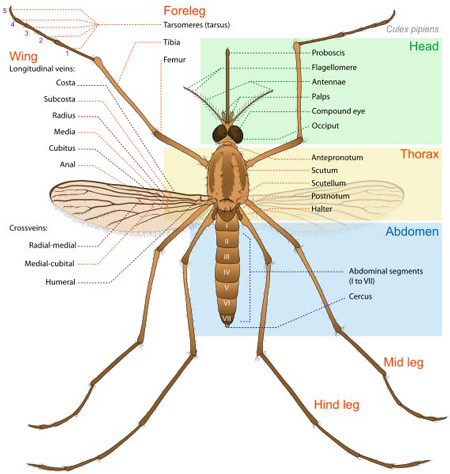Tiny Mosquito
The Mosquito - Body
|
Image copyright sciencekids.co.nz |
Like all insects, the mosquito has three basic body parts: head, thorax, and abdomen.
- Head: This is where all the sensors and the biting apparatus are located. The head consists of two compound eyes, antennae to sense chemicals and the mouth parts called the palpus and the proboscis (only in females).
- Thorax - This segment is where the two wings and six legs attach. It contains the flight muscles, compound heart and nerve cell ganglia and trachioles.
- Abdomen - This segment contains the digestive and excretory organs.
Mosquitoes are similar to flies in that they have two wings, yet unlike flies, their wings have scales. Their legs are also longer than those of flies, and the female mosquitoes have a long mouth part (proboscis) used for piercing the skin of their prey.
The Sensors
The head of the mosquito contains different sensors which aid the female in finding a host:
- Chemical sensors: These sensors enable mosquitoes to find their prey as they can detect carbon dioxide and lactic acid up to 100 feet away. Mammals and birds give off these gases when they breathe. Certain chemicals in sweat also attract mosquitoes.
- Visual sensors - Wearing clothing that contrasts with the background and even moving while wearing that clothing, helps mosquitoes see you and target you as their next prey. If you are moving, they know you are alive, and thus full of the blood they need.
- Heat sensors - Mosquitoes can detect heat. These special sensors help them find warm-blooded humans and/or animals when they are within a certain proximity.
Home - Mosquitoes - Bites - Control - Diseases - Resources - Site Map
